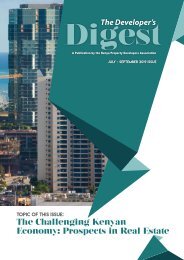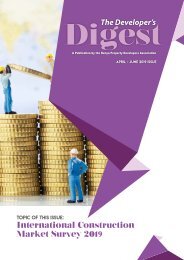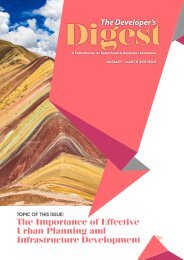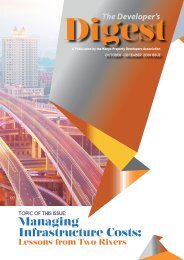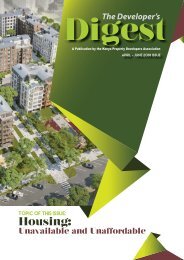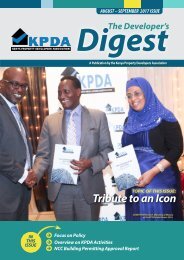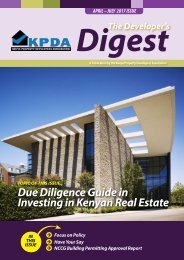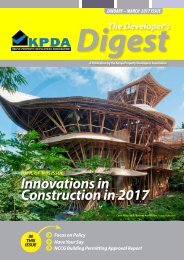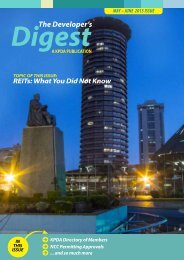The KPDA Bulletin - January to July 2020 Issue
Create successful ePaper yourself
Turn your PDF publications into a flip-book with our unique Google optimized e-Paper software.
J A N U A R Y T O J U L Y 2 0 2 0
THE KPDA BULLETIN
A Publication by the Kenya Property Developers Association
2020, What a Year! This Issue's
by Elizabeth Mwangi, KPDA CEO
Highlights
Welcome to the KPDA Bulletin, a publication aimed at bringing
you up to speed on the activities that your Association is
engaged in. It is also our intention to use this platform to share
what is trending globally in the real estate space.
2020 begun on a very hopeful note with most of us believing that
this would be the year that we recover from 2019's tough
economic times. Unfortunately, it has turned out to be a year
that promises to be even tougher than 2019 what with the Covid
19 global pandemic. Several businesses, and not only in the real
estate space have suffered the effects of the pandemic with
companies having to lay off staff , close certain
ventures/projects they may have begun and even close their
offices and branches.
Be that as it may, we remain hopeful that 2021 shall see us
bounce back. Let us not loose hope as all shall work out.
Advertise with KPDA at
80% Off!
“Affordable Housing Can
Become a Reality
for Cities”
The Tilisi Breakfast and
Tour
KPDA Directory of
Members
J A N U A R Y T O J U L Y 2 0 2 0
Highlights on KPDA's
Advocacy Activities
2019/2020
To be an advocate is to have courage,
independence and passion for the things that
matter..
We strive to represent you better and fulfill our mandate to
''proactively partner with policy-makers, financiers and
citizens to ensure that the property development industry grows
rapidly but in an organized, efficient, economical and ethical
manner.
Below are some of the highlights from the advocacy activities
that we have been engaged in:
- Representation on various Advocacy Meetings which included;
- Public Participation Workshop for the Drafting of the Special
Economic Zones Authority (SEZ) Regulations 2019 and the
Review of the 2016 Regulations.
- The 6th KEPSA National
Assembly
Speaker’s Roundtable (SRT) with
the 12th Parliament.
- The 5th KEPSA Senate Speaker’s
Roundtable
- NCA Workshop to Review and
Finalize the Draft Building
Regulations (Building Code).
Submissions on Various Pieces of
Legislation:
- The Business Laws (Amendment)
Bill 2019
- The Public Finance Management
Amendment Bill 2019
- The Sectional Properties Bill
2019
- Defects Liability Proposal from
the National Construction
Authority Regulations 2019
- The Land Registration
Amendment Bill 2020
- Tax Laws (Amendment) Bill 2020
KPDA has engaged
extensively with
the National
Assembly and the
Senate on key
strategies that can
be explored to
create a more
conducive business
environment for
private businesses
J A N U A R Y T O J U L Y 2 0 2 0
Key Wins for 2019
KPDA registered with the Joint Building and Construction
Council (JBCC) and therefore will be a member of its Board once
elections are held.
Affordable Housing Tax Incentives: Resulting from persistent
lobbying, the 2019/2020 Finance Act passed the following
incentives;
- VAT Exemption on goods imported or purchased locally for
use in affordable housing construction.
- Import Declaration Fee & Railway Development Levy
allowing for the fee at a rate of 1.5% shall be charged on the
custom value of input for the construction of houses under an
affordable housing scheme.
- Railway Development Levy allowing for the fee at a rate of
1.5% shall be charged on the custom value of input for the
construction of houses under an affordable housing scheme
The AHP Tax Incentive
Implementation Task Force was
constituted to develop the
implementation process and
respective regulations to
operationalize the passed
incentives and KPDA is
represented.
Public Appointments:
- Nomination of a KPDA Liaison to
the Proposed Money Laundering
and Terrorist Financing National
Risk Assessment Exercise under
the National Treasury (April
2019)
- Nomination to the Special
Subcommittee to Review the
National Construction Research
Agenda (NACRA) under the
National Construction Authority
(March 2019)
One of our key
advocacy
achievements for
2019 was the
inclusion of
affordable housing
incentives in the
Finance Act
2019/2020
J A N U A R Y T O J U L Y 2 0 2 0
Affordable Housing Can
Become a Reality for
Cities
By the World Economic Forum
Cities are growing at an unprecedented rate, presenting an
incredible opportunity for the development of local economies.
However, their residents need good, affordable housing – and
this remains a challenge around the world. Well-functioning
property markets can act as a financial springboard for
enterprises and job creation. An enabling environment for
affordable housing can be developed with the right
infrastructure, investment and macroeconomic policies targeted
towards social and financial inclusion.
Affordability – Exploring the Problem
The challenge of affordability requires not just short-term fixes
but also long-term strategies. Solutions will need to address both
the supply side and the demand side of the housing market, and
involve public-sector, private-sector and non-profit
stakeholders.
It is not only about being able to
afford to buy or rent a house, but
also being able to afford to live in
it. This goes beyond meeting
expenses related to operations
and maintenance; it also involves
considerations of transport,
infrastructure and services. If a
house is cheap enough to buy and
run, but located far from
livelihood opportunities or
amenities such as schools, it
cannot be said to be affordable.
The reasons for a lack of
affordability vary from city to
city, but commonly include
housing costs rising faster than
incomes, supply of houses not
keeping up with demand, scarcity
of land, and demographic changes
such as population growth, ageing
and changes in household
composition.
Supply-Side Challenge 2: Land
Use
City governments generally use
two tools – zoning and regulation
– to shape where and how new
houses can be built.
Consideration
is given to:
- Transit-oriented development,
in which expansion of cities is
planned around new urban
transport infrastructure.
- Algorithmic zoning, with
incentives for developers based
on assessment
of what is needed to maximize the
vibrancy of a community.
-
J A N U A R Y T O J U L Y 2 0 2 0
Rent controls offer the potential to
protect tenants, but must also take care not to
restrict the future supply of properties to rent by
unfairly disadvantaging landlords.
- Mixed-use development and inclusionary zoning, to ensure
neighbourhoods have a mix of income levels and proximity to
jobs and services.
- Taxation solutions, such as
taxing the underlying value of land rather than the value of the
property on it, and imposing a tax on vacant land or properties.
Supply-Side Challenge 3: Securing Finance
While some investors are starting to see affordable housing as a
low-risk addition to their portfolio – as demand from key
workers in public services is likely to remain strong through
recessions – the private sector naturally focuses on market rate
housing, where returns are expected to be higher.
The various options for funding the development of affordable
houses include:
- Government provision of tax incentives, grants or exemptions
for
private developers to develop certain types of property or
develop in
designated areas.
- Government-guaranteed bonds providing cheap, long-term
finance to community-based organizations to develop and
manage affordable housing.
- Employing investment models such as microfinance, real estate
investment trusts (REITs), impact investing and Islamic finance.
Supply-Side Challenge 4: Design and Construction
While land is often the biggest cost in developing housing,
construction costs are not far behind – and sometimes even
greater. It is important to look into how housing can be made
more affordable by bringing these costs down. Approaches
include:
- Minimizing bureaucracy, as the fees and costs of complying
with
complicated building codes can add significantly to project cost.
There is potential for technology to provide solutions here.
- Emerging construction
technologies such as 3D printing,
robot
bricklayers, self-driving
bulldozers – and solutions related
to the internet of things (IoT) and
artificial intelligence (AI) that
could bring down operational and
maintenance costs.
- Alternative construction
materials such as fly ash, cementcoated
expanded polystyrene panels,
glass fibre-reinforced gypsum,
cross-laminated timber and
compressed earth blocks.
- Public-private partnerships on
training to address skills
shortages in the construction
sector.
Demand-Side Challenges
Should strategies try to make
housing affordable for everyone,
or target assistance at certain
sections of the population? And
how should targeted populations
be defined: by income level, age,
number of children or
employment as key workers?
These form some of the
challenges on the demand side of
affordable housing, including:
Different forms of tenure, going
beyond a binary choice between
rental and home-ownership, can
offer more options to city
residents struggling to afford a
house. They include build-to-rent,
shared
ownership and shared equity
ownership.
J A N U A R Y T O J U L Y 2 0 2 0
Rent controls offer the potential to
protect tenants, but must also take care not to
restrict the future supply of properties to rent by
unfairly disadvantaging landlords.
Rent controls offer the potential to protect tenants, but must
also take care not to restrict the future supply of properties to
rent by unfairly disadvantaging landlords.
- Non-profit organizations such as
community land trusts, housing
cooperatives and microfinance
institutions have a critical role in
bridging the gap between
governments and the private
sector to improve the
affordability of housing, as well as
working with individuals to help
them understand their options
and make informed decisions.
Demand-side interventions need to guard against the risk of
helping in the short term but not the long term.
Mechanisms to keep units affordable on resale include subsidy
recapture and subsidy
retention.
Recommendations
Effective strategies need to address both supply and demand
side challenges. Recommendations for the three main
interdependent actors include:
- City governments have to define their long-term plans for
increasing
the supply of affordable housing, balancing the need to minimize
urban sprawl with the limits of the viability of building denser
and taller. They need to address political considerations that
could hold back the development of new affordable housing,
ensure that housing developments have adequate
infrastructure, explore ways to improve the situations of those
living in informal housing, and create a strong regulatory
enabling environment for the private and non-profit sectors
- Private-sector players need to keep abreast of emerging
solutions in construction techniques and materials, work with
governments to ensure an adequate flow of skilled labour, and
consider new solutions in financing and innovative tenure
models.
.
This article is an extract from a
report by the World Economic
Forum published in June 2019 on
Making Affordable Housing a
Reality in Cities. You may access
the full report using the link
http://www3.weforum.org/docs/WE
F_Making_Affordable_Housing_A_Re
ality_In_Cities_report.pdf
The World Economic Forum is the
International Organization for
Public-Private Cooperation.
The Forum engages the foremost
political, business, cultural and
other leaders of society to shape
global, regional and industry
agendas.
It was established in 1971 as a notfor-profit
foundation and is
headquartered in Geneva,
Switzerland. It is independent,
impartial and not tied to any special
interests.
The Forum strives in all its efforts to
demonstrate entrepreneurship in
the global public interest while
upholding the highest standards of
governance. Moral and intellectual
integrity is at the heart of
everything it does.
Visit https://www.weforum.org/
J A N U A R Y T O J U L Y 2 0 2 0
The Tilisi Breakfast and
Bus Tour, 26th February
2020
Event Summary
The Kenya Property Developers Association together with Tilisi
Developments PLC held a breakfast and tour on Tuesday,
25th February 2020.
The theme of the event was “Understanding the Advantages of
Developing a Master Planned Project.”
The event kicked off with a bus tour led by the Co – CEOs of
Tilisi Developments PLC, Ranee Nanji and Kavit Shah and
the Head of Sales, Jay Shah around the 400-acre development
explaining the investment opportunities around the
development.
he second session was characterized by a plenary session
moderated by Nick Langford, Adair Estates and included the
following panelists:
- Esther Omulele– Managing
Partner, MMC Asafo
- Simon N. C. Herd– Regional
Director for Sub-Saharan Africa,
Mace YMR
- Ravi Kohli– Founder & Managing
Director, Karibu Homes. Kenya
- Richard Hough– CEO, Africa
Logistics Properties
The audience comprised of
approximately 90 delegates who
were representatives from
KPDA’s membership.
We would like to send our
gratitude to Tilisi Developments
PLC for fully sponsoring and
hosting the event.
We look forward to organizing
future events together.For more
information, kindly contact the
KPDA Secretariat on 0725 286
689 or 0737 530 290.
To view more photographs from
these event, please click here
http://www.kpda.or.ke/the-tilisibreakfast-tour-tuesday-25thfebruary-2020.




